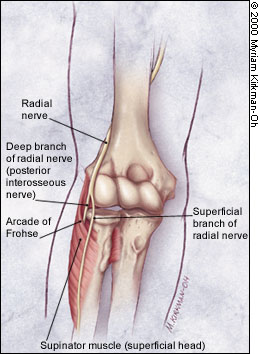Elbow Neurological Conditions
Introduction
The ulnar, radial, and median nerves all traverse the elbow, and disease processes of the elbow can affect any of these nerves.
Ulnar Neuropathy
Ulnar neuropathy is the most common compressive neuropathy of the elbow at an annual incidence rate of 21 per 100,000.
There are two main causes, direct trauma and idiopathic.
Idiopathic - nerve damage occurs due to:
- External compression;
- Traction during elbow flexion;
- A tight humeroulnar aponeurotic arcade; or
- A combination of these factors
Clinical presentation
- Numbness or paresthesia in the 5th and in the ulnar half of the 4th finger
- Feeling of weakness of the ulnar-innervated muscles, weakened grip or hand clumsiness
- Pain on the medial aspect of the elbow radiating to the forearm or hand.
Compression is normally at the retroepicondylar groove (80-85%) or under the humeroulnar aponeurotic arcade (20-25%) [1]. Ulnar nerve entrapment under the humeroulnar aponeurotic arcade affects primarily the dominant arms of older blue collar workers. External compression of the ulnar nerve in the retroepicondylar groove occurs mainly in the non-dominant arms of younger administrative workers and is due to external compression.
Surgical treatment involves decompression or nerve transposition at the cubital tunnel. A meta-analysis found that decompression was more effective and associated with fewer complications and lower risk of operation compared to transposition.[2]
Radial Tunnel Syndrome and Posterior Interosseous Nerve Entrapment
The posterior interosseous nerve is a pure motor branch of radial nerve. Clinical features include deep seated pain within the elbow and weakness of extension of the 3rd, 4th, and 5th digits.
Radial tunnel syndrome is a theoretical construct where there is entrapment of the radial nerve in the radial tunnel as it passes through the arcade of Frohse in the supinator muscle. There is not much evidence to support this, with only case reports [3]. There are no EMG studies that validate this[4]. MRI studies of patients with RTS usually show no pathology but in some cases they may show muscle edema or atrophy along the distribution of the radial and posterior interosseous nerves (finger extensors, supinator and less, pronator muscles) but the validity of the MRI findings is controversial [5]
See Rinkel et al for a somewhat recent systematic review of the effectiveness of interventions for cubital tunnel syndrome, radial tunnel syndrome, and bursitis of the elbow[6]
Anterior Interosseous Nerve Entrapment
The anterior interosseous nerve is a pure motor branch of the medial nerve. Clinical features include weakness of the flexor digitorum profundus of the 2nd and 3rd fingers. There is no sensory loss, however the patient may report paraesthetic pain at the elbow or over the proximal volar aspect of the forearm.
Neuroma
- Post-traumatic
- History of surgery or nerve injury
- Clinical presentation
- Sharp stabbing, shooting pain
- Point tenderness over the course of the nerve
- Neurological signs – loss of sensation, paraesthesias, muscle power loss
- Investigation
- MRI or ultrasound scan imaging
References
- ↑ Omejec G et al. What causes ulnar neuropathy at the elbow? Clinical neurophysiology. 2016. 127(1): 919 - 924
- ↑ Wade et al.. Safety and Outcomes of Different Surgical Techniques for Cubital Tunnel Decompression: A Systematic Review and Network Meta-analysis. JAMA network open 2020. 3:e2024352. PMID: 33231636. DOI. Full Text.
- ↑ Moradi A et al. Arch Bone Jt Surg. 2015 Jul; 3(3): 156–162.
- ↑ van Rossum J et al. Tennis elbow-A radial tunnel syndrome? J Bone Joint Surg Br. 1978;60(2):197–8.
- ↑ Ferdinand BD et al. MR Imaging Features of Radial Tunnel Syndrome: Initial Experience. Radiology. 2006;240(1):161–8.
- ↑ Rinkel WD et al. Current evidence for effectiveness of interventions for cubital tunnel syndrome, radial tunnel syndrome, instability, or bursitis of the elbow: a systematic review. Clin J Pain , 2013, Vol.29(12), p.1087-1096
Literature Review
- Reviews from the last 7 years: review articles, free review articles, systematic reviews, meta-analyses, NCBI Bookshelf
- Articles from all years: PubMed search, Google Scholar search.
- TRIP Database: clinical publications about evidence-based medicine.
- Other Wikis: Radiopaedia, Wikipedia Search, Wikipedia I Feel Lucky, Orthobullets,



